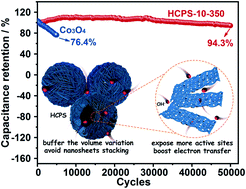Hollow CoP spheres assembled from porous nanosheets as high-rate and ultra-stable electrodes for advanced supercapacitors†
Abstract
The electrode materials with a high rate capability and excellent recycling ability are vitally critical for building the supercapacitors, but their synthesis remains a challenge. Herein, we have constructed hollow CoP spheres assembled from 2D porous nanosheet units (HCPS) through the controllable phosphatizing of the pre-designed Co-ethylene glycol (Co-EG) precursor. HCPS have several combined advantages benefiting as the electrode of the supercapacitors, including plentiful accessible ion/electron sites of porous nanosheets, good ability to buffer the volume variation of a hollow structure and enhanced mass/charge transfer due to the high conductivity of the phosphide. The tests show that the optimal HCPS electrode manifests good specific capacitance of 723 F g−1 at 1 A g−1, excellent rate property of 71.21% retention at 30 A g−1. Excitingly, HCPS exhibit super-long cycle stability with 94.3% retention exceeding 50 000 cycles, which can well rival carbon-based electrodes and stands at the forefront of the reported phosphide and oxide-based electrodes. Moreover, an asymmetric supercapacitor (ASC) device equipped with HCPS-positive electrode and negative B, N-doped graphitic carbon (BNGC) electrode presents a high energy density of 38.72 W h kg−1 at a higher power density of 8000 W kg−1 and remarkable stability (96.2% retention after 20 000 cycles), which certifies the promising potential of HCPS for high-efficiency energy storage.



 Please wait while we load your content...
Please wait while we load your content...